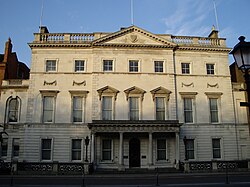Iveagh House
| Iveagh House | |
|
County Dublin | |
|---|---|
 Main façade of Iveagh House | |
| Type: | Government office |
| Location | |
| Grid reference: | O15983320 |
| Location: | 53°20’12"N, 6°15’34"W |
| City: | Dublin |
| History | |
| Address: | St Stephen's Green |
| Built 1736, 1862 | |
| For: | Robert Clayton by Richard Cassels Benjamin Guinness |
| Government office | |
| Neoclassical | |
| Information | |
| Owned by: | Government of Ireland |
Iveagh House in Dublin is the headquarters of the Department of Foreign Affairs and Trade, part of the Irish Government. The name ‘Iveagh House’ is also sometimes used colloquially as a metonym referring to the department itself.
Iveagh House was originally two houses, nos 80 and 81 St Stephen's Green. No. 80 was designed by Richard Cassels in 1736 for Bishop Clayton. It was later the home of barrister and Master of the Rolls in Ireland, John Philpot Curran.
After both houses were bought by Benjamin Guinness in 1862, he acted as his own architect, combined the two houses and produced the building as it now stands. On the Portland stone facade pediment he placed his parents' arms: on the left the Milesian lion, with the Red Hand of Ulster above, for the Magennis clan of County Down; and on the right the arms of the Lee family, Dublin builders from about 1700.
The building has nine bays, with the central three broken forward and pedimented. The interior of the building is hugely elaborate and decorative, with a staircase and ballroom lined with alabaster. The staircase also has ornate ironwork, marble columns and circular roof lights.

The building was donated to the Irish state by Benjamin Guinness's grandson, Rupert Guinness, 2nd Earl of Iveagh, in 1939, and was renamed Iveagh House. (The original 'Iveagh House' is still a part of the Iveagh Trust nearby.)
The Iveagh Gardens at the back of the house were given to University College, Dublin by Edward Cecil Guinness, 1st Earl of Iveagh, in 1908, in connection with the formation of its campus on Earlsfort Terrace. The gardens have since been transferred to the Office of Public Works| and are now used as a public park. The conservation and restoration of the Gardens commenced in 1995 and to date most of the original features have been restored, for example the Maze in Box hedging with a sundial as a centrepiece. The restored Cascade and exotic tree ferns all help to create a sense of wonder in the 'Secret Garden'.
Outside links
| ("Wikimedia Commons" has material about Iveagh House) |